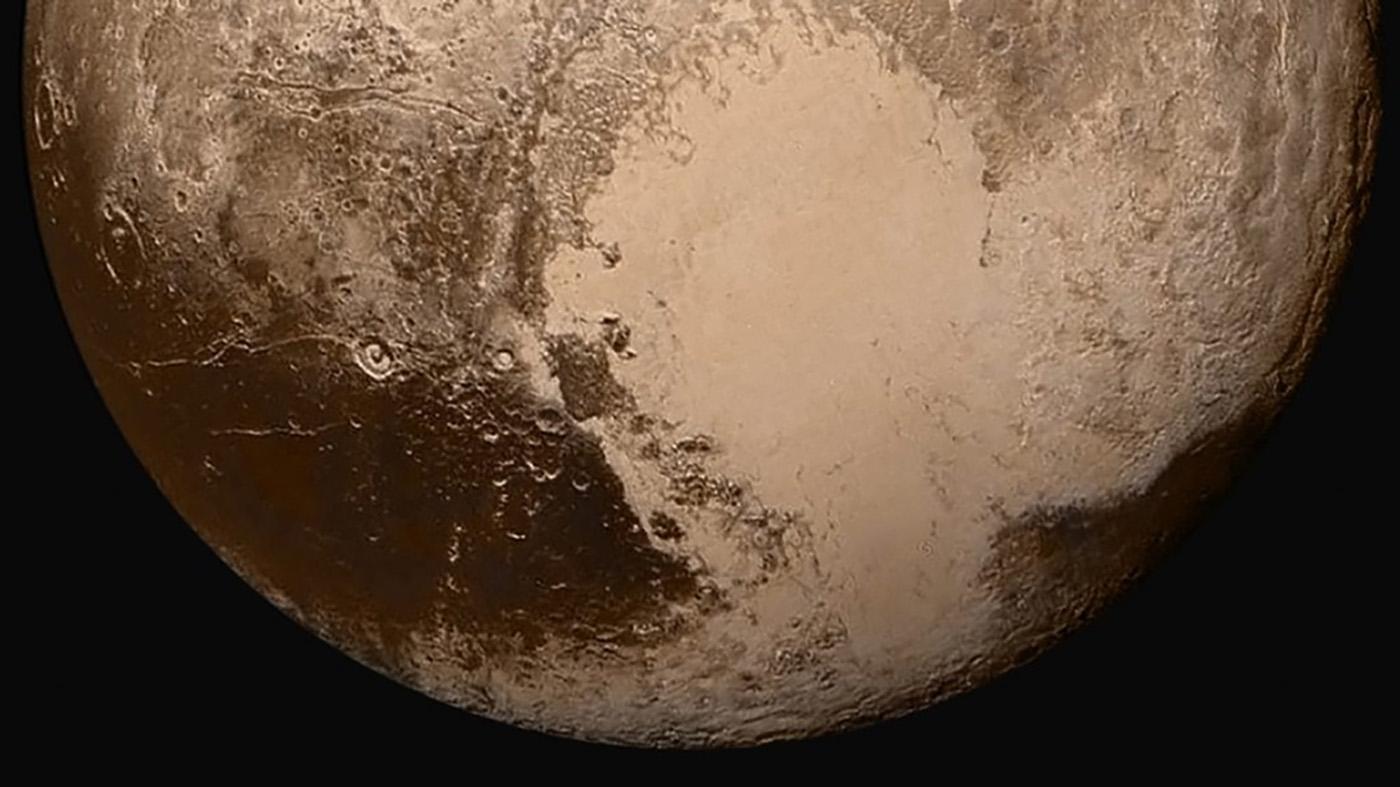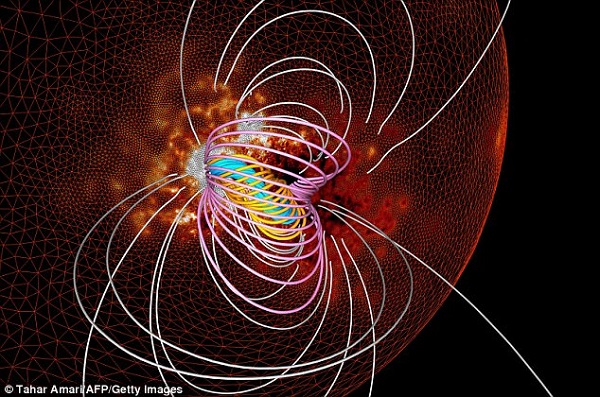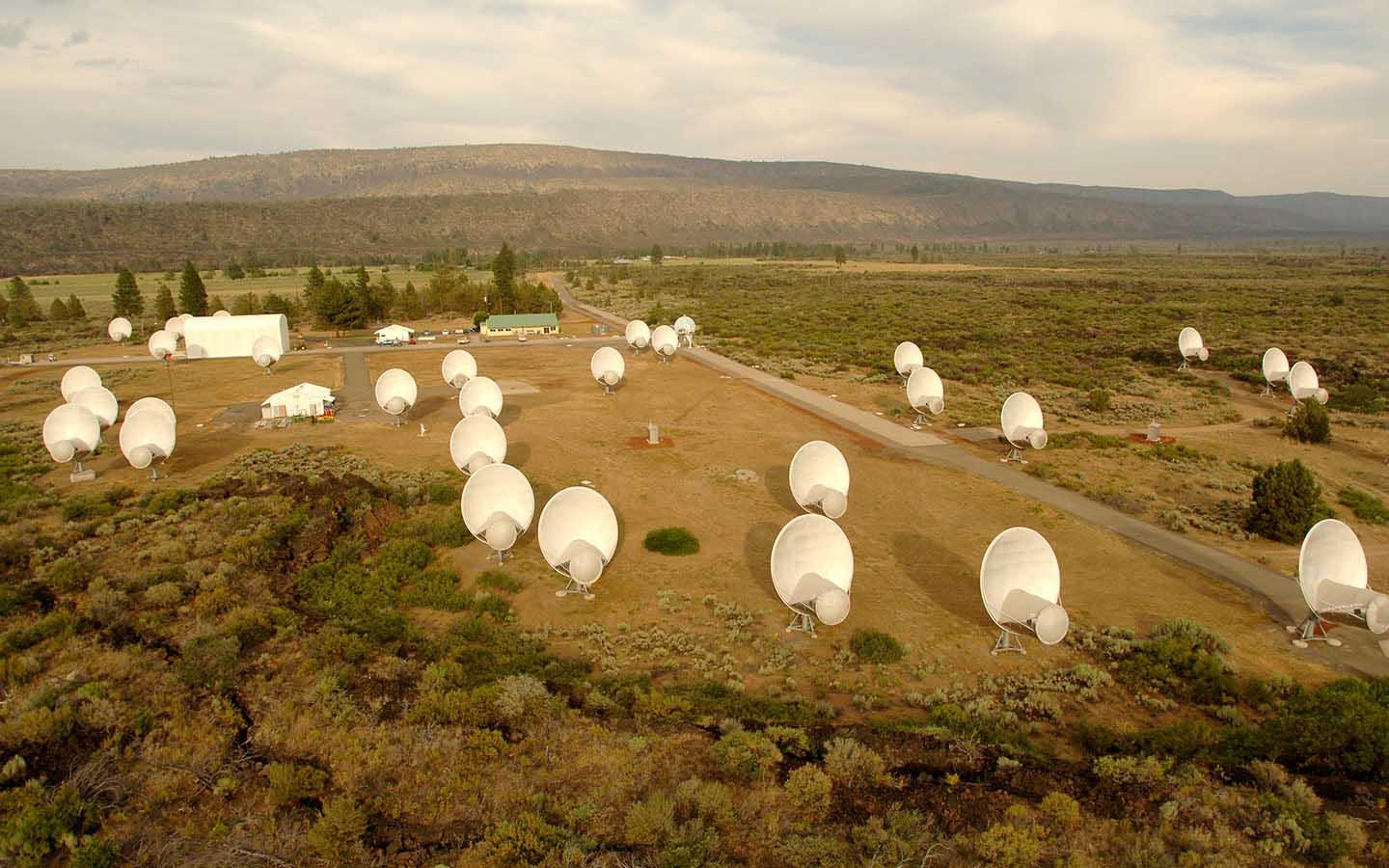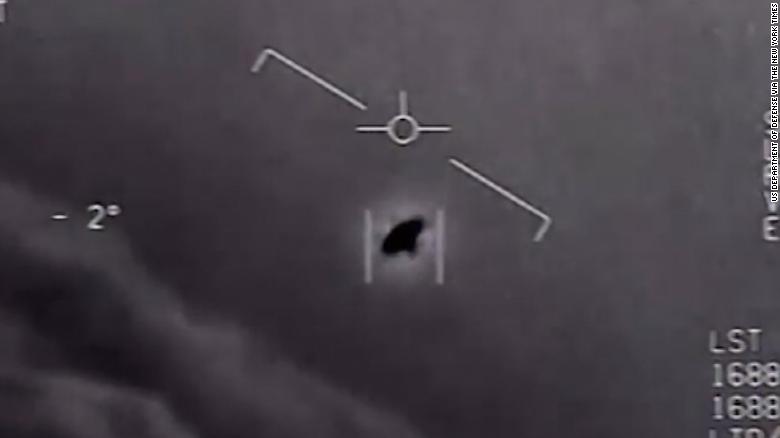
Cristina Dalle Ore, a senior scientist at the SETI Institute, led a study recently published in Science Advances that suggests the possibility of cryovolcanoes, or ice volcanos, on the surface of Pluto. Based on a review of data collected by NASA’s New Horizons spacecraft from its 2015 flyby, the study looks at the presence of ammonia mixed with water ice, which appears to have been sprayed up from beneath the surface. Dalle Ore explained the significance of ammonia to Cosmos Magazine:
It’s an exciting find, says Cristina Dalle Ore, a planetary scientist at the Search for Extraterrestrial Intelligence (SETI) Institute and NASA Ames Research Centre, California, because by geological standards, ammonia can’t survive long on the surface of Pluto without being destroyed by ultraviolet light, cosmic rays, or other radiation.
“It’s really fragile,” she says. “When you have ammonia on the surface, that means that it got there recently.”
Dalle Ore thinks the presence of ammonia means there may be an underground ocean on Pluto hiding under a layer of gas hydrates (also called “fire ice”):
“Between that, which keeps it warmer, and the ammonia that allows the water to be liquid at cold temperatures, [we have] more evidence that we have an ocean,” she says.
Ammonia is also exciting, she adds, because it is an important precursor to prebiotic chemistry, including the formation of amino acids and a cascade of other biologically interesting chemicals.
“We’re not talking aliens,” she adds. “We’re not talking life. But we are talking the possibility of an environment that could foster it. That is one of the main reasons that ammonia is so interesting.”
Pluto may be considered to be a dwarf planet these days, but it has only gotten more interesting with time!
- Cosmos: Pluto ammonia find suggests a possible life-friendly ocean
- Astronomy: Ammonia on Pluto’s surface points to liquid water underground
- Facebook: Spacebook Live with Cristina Dalle Ore
 Catch a Falling Star
Catch a Falling StarPeter Jenniskens, a senior research scientist at the SETI Institute, is an expert on meteor showers and a meteor storm chaser. Jenniskens leads the NASA sponsored Cameras for Allsky Meteor Surveillance (CAMS) project, a network of cameras designed to detect and map meteor showers, as he explained to Stuff:
"I realised we had to map our meteor showers somehow. We can do that with video cameras. We basically needed a video surveillance of the night sky and for that, we needed to scale up the triangulation of the meteor trajectories. We needed to develop the software and to do that with hundreds of cameras."
The front page of The Ashburton Courier June 2019 edition covered the installation of one such site on the roof of a family home in Fairton, New Zealand (the family was reportedly interested in astronomy and well-situated between two other New Zealand sites for triangulation). On the CAMS website, CAMS.SETI.org, Jenniskens reported, “The new station has increased the yield of CAMS New Zealand four-fold, reaching 289 meteors in the clear night of June 5”. Other sites are being set up in Namibia, South America, and Australia.
- The Ashburton Courier: Cameras on meteor hunt
- Stuff: Unlocking New Zealand's meteor showers to discover whether life really is out there
 Planet Hunt
Planet HuntA mission to image planets similar to Earth – to see if we can spot another “pale blue dot”, as Carl Sagan once described our fragile home – takes searching for exoplanets to the next level. Called Project Blue, the search for a sister Earth not only has significant implications for SETI, but it also has a profound impact on the global community as we contemplate the question at the heart of the SETI Institute’s mission: are we alone? Even capturing a single pixel of a world around another star would provide important insights, as SETI Institute research scientists Margaret Turnbull told Science Focus:
“Monitoring the brightness and the colour of planets over time is what allows you to make maps of the surface,” says Dr. Margaret Turnbull of the Carl Sagan Center for Research at The SETI Institute, California, and a member of the Project Blue team. “Are there oceans? Are there continents? Are there cloud patterns? Weather patterns? Seasons? If there are, all of those things should be reflected – literally – in the colour data and in the brightness of the planet over time.”
Will we discover a world like ours, home to other beings looking at the stars with wonder?
- Science Focus: Project Blue: the hunt for Earth’s sister
- SETI.org: Project Blue and the Quest to Photograph Exoplanets
 Missing Notes in a Solar Symphony
Missing Notes in a Solar SymphonyFrontier Development Lab (FDL) is an applied artificial intelligence research accelerator that applies AI technologies to the challenges of space science. One of the challenges FDL participants tackled in 2018 had to do with the Solar Dynamics Observatory (SDO) satellite – one of its components, used for measuring extreme ultraviolet radiation, broke. Graham Mackintosh, an AI consultant with FDL, explained what the team faced:
“Imagine that you had listened to a symphony playing music for four years,” said Graham Mackintosh at NASA FDL, “and then one of the musicians suddenly stopped playing. Would you be able to mentally fill in the missing music from the performer who had gone silent? This is what the NASA FDL team wanted to do with the symphony of data coming from NASA’s Solar Dynamics Observatory.”
Using common software and hardware, the AI was developed to fill in the missing data and may have further uses in predictive models.
The FDL 2019 is about to begin! Find out more at SETI.org.
 A Short History of SETI
A Short History of SETIThe recently published WIRED Guide to Aliens offered an enjoyable overview of the modern scientific search for advanced extraterrestrial life, from Project Ozma in 1960 to the SETI Institute’s recently launched TechnoSearch database. While the search for extraterrestrial intelligence (SETI) has been the work of several groups and organizations, the SETI Institute has played a key role from the start:
One of Green Bank’s early employees was a man named Frank Drake. Drake, like many scientists, read a 1959 Nature paper by physicists Guiseppe Cocconi and Philip Morrison, who suggested that if a person wanted to find intelligent aliens (here, “intelligent” means capable of using technology to transmit an identifiable signal) they might try picking up radio broadcasts, and they suggested a range of frequencies scientists could search. This fired Drake up, and in 1960 the observatory’s director agreed to let him point an 85-foot telescope at two sun-esque stars, tuning it into the kinds of transmissions that could come from technology and not from stars, gas, or galaxies.
It didn’t, but the effort, called Project Ozma, kicked off the modern SETI enterprise. A year later, Green Bank hosted a secret National Academy of Sciences meeting at which Drake presented the now-famous and now-eponymous Drake Equation.
Drake would go on to be among the first trustees of the SETI Institute’s board, a dedicated non-profit research organization focused on research and education around the factors of the Drake Equation. Later, following a NASA study called Project Cyclops, which laid out a possible radio telescope project to search the stars for extraterrestrial signals, another major figure in SETI would emerge:
The project never happened, but it did inspire Berkeley professor Stuart Bowyer and Berkeley student Jill Tarter to start a smaller-scale program called SERENDIP: the Search for Extraterrestrial Radio Emissions from Nearby Developed Intelligent Populations.
Tarter later co-founded the SETI Institute and today serves as Chair Emeritus for SETI research. The SETI Institute continued and expanded NASA’s earlier efforts, first through a comprehensive search for radio signals of extraterrestrial technological origin, Project Phoenix. Some years later, SETI Institute and others came together to build the Allen Telescope Array, with the intent of providing the SETI community with a dedicated telescope for the search, rather than exclusively relying on shared time on radio astronomy instruments. Recently, TechnoSearch was launched as a web-based archive, allowing researchers around the world to review older studies and update the community with new ones without digging through old journals or facing paywalls.
You can find out more about the SETI Institute’s ongoing work at SETI.org.
- Wired: The WIRED Guide to Aliens
- SETI.org: The First Comprehensive, Interactive Tool to Track SETI Searches
 Real UFOs… Not Really Aliens
Real UFOs… Not Really AliensHave you ever seen strange lights in the sky, and wondered… was it aliens?!?
Lots of folks have seen UFOs and no one questions that they are real – after all, UFO simply means “unidentified flying object”. Recent media coverage of Navy pilots reporting unexplained sightings has led to increased interest and speculation that we might have visitors from across the stars doing a little tourism. However, as Seth Shostak, Senior Astronomer at the SETI Institute, told LiveScience, we shouldn’t be too eager to assume the phenomena means aliens are zooming around right overhead:
"The sightings always recede to the edge of what technology allows you to do," Shostak said. "The aliens are kind of keeping pace with technology."
Common sense also argues against jumping to the E.T. conclusion. If these UFOs are indeed alien spacecraft, what exactly are they doing? Why were they sent here, across the vast gulfs of space and time?
"If the aliens are here, you gotta say they're the best houseguests ever because they never do anything," Shostak said. "They just buzz around. They don't address climate change; they don't steal our molybdenum."
Given the incredible distances of space and the proliferation of cameras all over Earth (cell phones, drones, security, etc.) that have failed to capture non-blurry images of alien spacecraft, it seems extraordinarily unlikely that aliens are buzzing the skies. Still, Shostak encourages further study into UFO reports, as they may represent anything from software glitches to foreign (but human) reconnaissance:
"It's not trivial to say what these things are," he said. And Shostak applauded a newly enacted classified Navy policy, as reported by the Times, instructing pilots on how to report UFOs (which the military, and many other people, now call "unexplained aerial phenomena," likely in an attempt to dodge the tinfoil-hat stigma associated with the term "UFO.")
"That's a good policy," he said. "Let them do it."
In last week’s episode, what you don’t know about animals will surprise you in an encore of Creature Discomforts. On our previous week’s episode, Big Picture Science examined scary statistics while avoiding the “intelligence trap”, in Skeptic Check: Worrier Mentality.
Last time on Facebook Live, SETI Institute senior astronomer Seth Shostak spoke with Cristina Dalle Ore about her work to understand the surface of Pluto. Videos of all past Facebook Live events can be found on our Facebook page: https://www.facebook.com/SETIInstitute/
- AlienCon 2019: June 21-23. 2019, Los Angeles, CA SETI Institute Senior Astronomer Seth Shostak is one of the featured speakers
- AbSciCon: June 24-28, 2019, Bellevue WA The SETI Institute will be a participating sponsor and numerous SETI Institute scientists will be presenting their work
- Starmus V – A Giant Leap: June 24-29, 2019: Zurich, Switzerland Jill Tarter, co-founder of the SETI Institute, is on the Starmus advisory board and will be one of the featured speakers
- IAU Chile: June 30-July 6, 2019, Copiapo, Chile SETI Institute research scientist Meng Jin will offer a talk: Coronal dimming as a proxy for stellar CMEs
- Astronomy Nights on Mount Tamalpais – Cassini’s Spectacular Final Year at Saturn: July 13, 2019, Mill Valley, CA SETI Institute senior research scientist Matthew Tiscareno is the scheduled speaker





